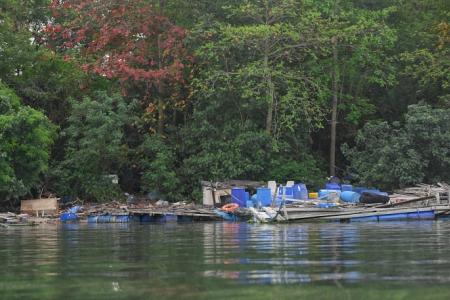Fish farm structures strewn along shoreline of Pulau Ketam
Abandoned fish farm structures, barges, large wooden planks and even a boat have been found along the shoreline of Pulau Ketam, close to Pulau Ubin.
During a visit earlier in October, The Straits Times also discovered that large pieces of debris were strewn in the forested areas on the island, and at low tide, previously submerged structures became visible.
The Singapore Food Agency (SFA) said it is aware of the clutter and that clean-up is in the works.
“Dismantling and proper disposal of these structures are planned to be completed by December, dependent on weather conditions and the availability of volunteers,” said a spokesman.
“SFA is also working with coastal farms to manage farm structures and loose equipment. Farms are required to ensure their farm structures are secured.”
The agency did not say if the clutter would be considered illegal dumping.
ST understands that the fish farm operator responsible for the clutter is Mr Phillip Lim of Sea Angel Marine.
SFA said that “the farm operator is also helping to secure other unidentified drifting structures by placing them on the coast temporarily to prevent navigational hazards”.
The debris is found along the southern shoreline of Pulau Ketam, which is opposite Sea Angel Marine.
Among the clutter is a large farm structure that includes a shelter, platforms and furniture. It bears the farm number FC110E, which belongs to Ocean King Harvest.
This was the former name of Sea Angel Marine, according to records from the Accounting and Corporate Regulatory Authority (Acra), although it is unclear if the farm belonged to Mr Lim.
Another structure has “FC63E” imprinted on it, which belongs to a Mr Lim Swa Sheng, according to the 2022 farm licence records from SFA.
ST had asked Mr Lim if the FC110E farm belonged to him.
Both farms were no longer listed in the farm licence records as at October, which means that they had already relinquished their licences and exited the industry.
Both Mr Lim and SFA did not respond to queries on how long the clutter had been there.
Dr Tay Choon Nghee, a senior director from Prime Group International, which owns a fish farm on Pulau Ketam, said that the clutter on the island’s southern shoreline has been “growing steadily” in the past few months, likely due to many fish farms moving out of the East Johor Strait.
ST reported on Oct 25 that the number of fish farms has fallen over the years, from 98 in 2023 to 74 as at Oct 4. SFA had offered a support package of $100,000 to help them move out.
Dr Tay said that there is still sufficient space for boats to navigate despite the clutter.
“Presently, it is not imposing on our farm operations as we draw clean water from the northern part of the island, in a channel between Pulau Ubin and Pulau Ketam,” he said.
Ms Sue Ye, founder of Marine Stewards, a marine conservation non-governmental organisation, noted that the clutter appeared this year, suggesting that a fish farm may have been abandoned there.
Some materials from the farm structures, if left there for a long time, may degrade and leach into the waters, affecting the habitats of native biodiversity, she added.
Mr Yasser Amin, who is chief officer of not-for-profit organisation Stridy, said: “Major parts of the clutter seem to be large rafts that are made up of wooden structures tied to the blue barrels. This is not something that a voluntary group can or should work with to remove.”
“To the best of my knowledge, (this) would require professional waste removal services,” he added.
Stridy regularly organises clean-ups in urban areas in collaboration with corporations and schools.
While beach clean-up groups sometimes deal with large items such as fridges, huge tyres and blue barrels, the scale of the clutter on Pulau Ketam would likely be beyond their abilities, Mr Yasser added.
Mr Yasser and Ms Ye said they have not been approached to help remove the clutter on Pulau Ketam.
Ms Ye said: “We recommend that they engage a professional removal or salvage company to safely remove and dispose of it.”
Mr Ivan Francis Danakody, operations director of Singapore Salvage Engineers – which specialises in sea-based wreck removal and disposal – noted that demolishing and disposing of each fish farm structure is “very expensive,” potentially costing between $60,000 and $70,000.
Clearing all the clutter would therefore cost a few times of that, depending on the amount of debris on the seabed.
Mr Danakody said the process would entail sending out a crane barge to dismantle the infrastructure, and take it back to the company’s shipyard in Tuas.
The structures are then sorted according to material – wood, metal or plastic – and cut into small pieces for disposal, according to specific requirements by the National Environment Agency.
In 2021, a question was raised in Parliament on the kind of waste generated by Singapore’s fish farms and the collection processes to ensure that the waste does not end up in the sea. Minister for Sustainability and the Environment Grace Fu said the waste included organic matter like fish faeces and dead fish, as well as general refuse.
“As waste from fish farms are commingled and collected with other waste, data is not available on the amount of waste produced by fish farms,” she added.
SFA’s licensing condition requires sea-based fish farms to bag, transport and dispose of their waste on land, with waste collection points available at the Lim Chu Kang and Lorong Halus jetties for farms located in the western and eastern Strait of Johor, she noted.
Get The New Paper on your phone with the free TNP app. Download from the Apple App Store or Google Play Store now


